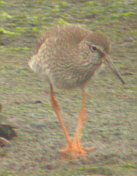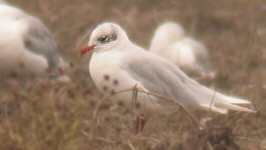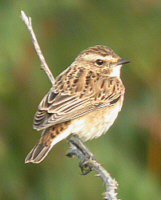Last updated 20:00 on the 31st

Camberwell Beauty - Gunton - August 2002 - Peter Wright
Red-throated Diver Gavia stellata
Noted past Kessingland on the 21st (1 S @ 14:20), 26th (1 S @ 14:20) and 27th (1 N @ 18:35). Great Crested Grebe Podiceps cristatus
Noted past Kessingland on the 3rd (1 S), 7th (1 o/s), 10th (2 S), 14th (1 N), 22nd (1 N), 23rd (1 S).
Black-necked
Grebe Podiceps nigricollis
A juvenile drifted north on the sea past Kessingland at 10:00 on the 9th
and was only 10 metres offshore.
Fulmar
Fulmarus glacialis
Kessingland:
1st (1 N), 3rd (1 N, 1S), 4th (3 N, 2 S), 6th (2 N), 7th (4 N, 2 S), 8th
(1 S), 9th (2 S), 10th (5 N), 11th (2 N, 1 S), 12th (1 N, 3 S), 14th (2
N, 1 S), 15th (3 N, 2 S), 16th (1 S), 17th (2 N, 2 S), 18th (1 N), 19th
(2 N, 1 S), 20th (4 N, 3 S), 21st (8 N, 2 S), 22nd (7 N, 1 S), 23rd (8 N,
1 S), 25th (2 S), 26th (10 N), 27th (7 N, 1 S), 28th (9 N, 4 S), 30th (9
N).
Ness Point: 6th (3 N), 7th (3), 18th (1 S), 21st (1 N), 24th (3), 25th (1
N), 26th (12), 27th (26 N), 31st (1 N). On the 24th one disoriented individual
was circling over Belle Vue Park. And on the 27th seven that flew north
over Lowestoft North Denes included a group of four. There was even an inland
sighting - one south over Norwich Road !!!
Manx
Shearwater Puffinus puffinus
At 07:20 on the 12th a distant Manx flew north past Kessingland. Another
went north past Gorleston @ 16:10 on the 25th.
Sooty Shearwater Puffinus griseus
Three flew north past Ness Point on the afternoon of the 27th in strong
northerly winds. They passed at 13:20, 15:05 and 15:25. One which flew north
past Kessingland the same day at 13:55 was probably additional to the Ness
Point sightings. A single rather distant individual flew north past Lowestoft
at 16:45 on the 31st.
Gannet Morus bassanus
Kessingland: 1st (3 N, 2 S), 2nd (41 N, 2 S), 3rd (23 N, 3 S), 4th (31 N,
7 S), 5th (4 N), 6th (11 N, 1 S), 7th (12 N), 8th (21 N, 1 S), 9th (10 N,
3 S), 10th (18 N, 10 S), 12th (2 N, 1 S), 13th (8 N, 2 S), 14th (8 N), 15th
(5 N), 16th (3 N), 17th (4 N), 18th (1 S), 19th (15 N, 2 S), 20th (6 N),
21st (22 N, 1 S), 22nd (57 N, 16 S), 23rd (64 N, 10 S), 24th (2 N), 25th
(9 N), 26th (8 N, 1 S), 27th (19 N, 2 S), 28th (33 N), 29th (16 N), 30th
(47 N).
Ness Point: 5th (8), 6th (19 N), 7th (30), 19th (2 N), 21st (32), 25th (6
N), 26th (6 N), 27th (52 N, 1 S), 30th (5 N), 31st (3 N).
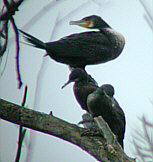 |
Cormorant
Phalacrocorax carbo Shag
Phalacrocorax aristotelis |
Little
Egret Egretta garzetta
One was feeding on Breydon South Shore on the 4th. In the 1991 Suffolk
Bird Report they were described as 'A rare passage migrant'. Over the last
eleven years they have become increasingly common nationally and in May
of this year a flock of eleven flew north past Kessingland Beach.
Grey Heron Ardea cinerea
One flew north past Kessingland on the 4th.
Greylag Goose Anser anser
52 were at Lound water works on the 25th.
Canada Goose Anser canadensis
175 were at Lound water works on the 25th.
Barnacle Goose Branta leucopsis
Noted at Lound water works on the 11th (60), 16th (77), 25th (239); and
Kessingland Church on the 21st (85) in field south of church.
Brent Goose Branta leucopsis
Noted past Kessingland on the 3rd (1 N) and Ness Point on the 6th (2
N).
Shelduck
Tadorna tadorna
Noted past Kessingland on the 6th (5 N), 8th (1 S), 21st (5 S), 22nd (2
N), 23rd (4 S), 27th (16 N), 30th (5 S).
Wigeon Anas penelope
Noted past Kessingland on the 19th (5 S), 25th (9 N, 10 S), 27th (34 N,
8 S), 28th (8 S); and Ness Point 26th (3 S).
Shoveler
Anas clypeata
Noted past Kessingland on the 19th (1 S).
Teal Anas
crecca
Noted past Kessingland on the 1st (5 S), 2nd (4 S), 3rd (15 S), 4th (54
S), 6th (7 N, 13 S), 9th (12 S), 10th (30 S), 11th (6 S), 13th (4 S), 14th
(2 S), 15th (43 S), 16th (45 S), 17th (135 S), 18th (70 S), 19th (94 S),
21st (12 N), 22nd (37 N), 23rd (8 N, 37 S), 24th (21 S), 25th (14 N, 29
S), 26th (30 N, 43 S), 27th (17 N, 123 S), 28th (12 N), 30th (5 S); Corton
25th (9 N, 25 S); and Ness Point 26th (48 S, 9 N), 27th (25 S).
Eider
Somateria mollissima
Noted past Kessingland on the 3rd (1 S), 17th (1 N); and Ness Point 6th
(2 f. N), 27th (12 N).
Common
Scoter Melanitta nigra
Noted past Kessingland on the 3rd (5 N, 15 S, 2 o/s), 4th (6 N, 9 S),
5th (4 S, 11 o/s), 6th (1 N, 15 S, 5 o/s), 7th (2 N, 5 o/s), 8th (5 S),
9th (1 S), 10th (1 N, 18 S), 12th (4 S), 13th (5 S), 15th (3 N, 27 S), 16th
(20 S), 17th (9 S), 18th (1 N, 25 S, 9 o/s), 19th (6 N, 2 o/s), 22nd (2
o/s), 23rd (1 N, 19 S), 24th (2 S), 25th (1 N, 2 o/s), 26th (10 N, 2 o/s),
27th (11 N, 8 S), 28th (1 N); and Ness Point on the 3rd (1 S), 5th (9 N),
13th (1 N), 18th (1 N), 19th (10 S), 21st (5), 25th (18 N), 27th (20 N,
11 o/s).
Common Buzzard Buteo buteo
On a day when one or two were on the move in East Anglia one was seen at
Ashby in the company of a Marsh Harrier Circus aeruginosus on the
17th. One flew south past Kessingland at 9:30 on the 22nd. Initially it
was low to the sea within 100 metres of the beach, before rising rapidly
in a thermal and drifting slowly south. At 9:50 the same bird flew north
towards Lowestoft.
Hobby Falco subbuteo
Noted at Gunton on the 15th (1 S); Corton 23rd; Belle Vue Park 24th and
Corton Sewage Works, adult and juvenile together on the 31st.
Common Crane Grus grus
On one of the warmest days of the summer two were seen at Ashby on the 17th.
They flew in from the north and were last seen heading towards Lound.
Oystercatcher Haematopus ostralegus
Noted past Kessingland on the 1st (5 S), 2nd (7 S), 3rd (10 S), 4th (1 S),
5th (8 N, 2 S), 6th (24 N, 14 S), 7th (10 N), 8th (6 S), 9th (9 S), 10th
(2 S), 11th (2 N, 1 S), 12th (2 N, 1 S), 13th (2 N, 22 S), 15th (7 S), 17th
(6 S), 18th (1 N, 6 S), 19th (3 S), 20th (10 S), 21st (5 N, 10 S), 22nd
(1 N, 5 S), 23rd (2 N), 24th (1 N), 25th (1 N), 27th (2 N, 1 S), 30th (2
S); and Ness Point 6th (7 S), 17th (1 S), 24th (3), 27th (1 N), 28th (1),
31st (5 N).
Ringed
Plover Charadrius hiaticula
One was at Ness Point on the 3rd and 6th.
Grey Plover Pluvialis squatarola
Noted past Kessingland on the 1st (1 S), 3rd (1 S), 4th (2 S), 6th (1 S),
7th (1 N), 8th (4 S), 10th (1 S), 15th (7 S), 16th (1 N), 19th (1 S), 23rd
(1 S), 26th (1 S), 28th (1 S); and Ness Point on the 3rd (1 S) and 6th (2
N).
Golden Plover Pluvialis apricaria
Noted past Ness Point on the 21st (5).
Knot Calidris canutus
Noted past Kessingland on the 1st (6 S), 6th (3 N), 7th (7 N), 8th (1 S),
9th (2 S), 12th (3 N), 18th (9 S), 19th (3 S), 26th (7 N); and Ness Point
on the 6th (1 N), 27th (1 N).
Sanderling Calidris alba
Noted along Lowestoft North Beach on the 12th (4), 14th (3 S), 21st (1),
27th (16 N); and Kessingland 30th (10 feeding on beach).
Turnstone Arenaria interpres
Numbers have been increasing through the month at Ness Point on the 4th
(2), 6th (6), 12th (12), 17th (2), 18th (8), 24th (13), 26th (6), 27th (2),
28th (3), 30th (c30 S). Noted past Kessingland 19th (4 S), 20th (4 S), 27th
(25 S).
Dunlin Calidris alpina
Noted past Kessingland on the 1st (1 S), 2nd (1 S), 6th (6 N), 7th (10 N),
9th (4 S), 10th (2 S), 15th (2 S), 17th (5 S), 18th (15 S), 19th (2 S),
20th (2 S), 22nd (5 S), 27th (7 N); and Ness Point on the 3rd (3), 27th
(1).
Curlew Sandpiper Calidris ferruginea
Four adults were on Breydon South Shore on the 4th.
Wood Sandpiper Tringa glareola
One was with the Green Sandpiper at Corton sewage works on the 4th before
flying off. Presumably the same bird was back on the 5th where it remained
on one of the small pools all day.
Green Sandpiper Tringa ochropus
One was at Corton sewage works on the 4th before flying off high to the
west. One flew north past Lowestoft South Beach on the 4th with another
past Ness Point on the 6th.
Common Sandpiper Actitis hypoleucos
Noted at Burgh Castle Flats 4th (1); Lound water works 16th (12), 18th (1),
25th (1); Ness Point 18th (1), 26th (1); Corton 18th (3); Belle Vue Park
24th (1 over), Hamilton Dock 31st (1).
|
Redshank
Tringa totanus |
|
Spotted
Redshank Tringa erythropus
One was on Burgh Castle Flats on the 4th with one winter plumaged bird on
the 16th.
Greenshank
Tringa nebularia
Three were on Burgh Castle Flats on the 4th.
Black-tailed Godwit Limosa limosa
Noted past Kessingland on the 15th (5 S).
Bar-tailed
Godwit Limosa lapponica
Noted past Kessingland on the 1st (1 S), 6th (3 N), 7th (1 N), 8th (1 S),
11th (1 S), 12th (1 N), 15th (4 S), 17th (3 S), 18th (3 S), 19th (13 S),
23rd (1 S); and Ness Point on the 6th (2 N).
Curlew
Numenius arquata
Noted past Kessingland on the 1st (2 S), 2nd (1 S), 5th (1 S), 15th (1 S),
18th (1 S), 19th (3 S), 23rd (1 S); Lowestoft North Denes (4 heading inland
over the net-posts); Corton sewage works 26th (1 in field).
Whimbrel
Numenius phaeopus
Noted past Kessingland on the 1st (5 S), 2nd (51 S), 3rd (2 S), 4th (11
S), 5th (1 S), 8th (3 S), 9th (2 S), 12th (4 S), 13th (3 S), 14th (3 N),
15th (1 S), 16th (1 S), 17th (14 S), 18th (9 S), 19th (14 S), 22nd (6 S),
23rd (1 S), 27th (7 S), 28th (1 S), 30th (7 S); Ness Point on the 3rd (1
S), 6th (3 N), 9th (4 S), 30th (4 S); Pakefield 5th (1 N); and Gorleston
Cliffs on the 8th (1 S).
Ruff Philomachus pugnax
Eight were on Burgh Castle Flats on the 4th with six on the 16th.
Great Skua
Catharacta skua
Noted past Kessingland on the 1st (1 S @ 06:25 1km offshore), 3rd (1
N @ 17:40), 8th (1 N @ 14:20), 10th (1 N @ 06:25) and 30th (1 S @ 09:50);
and Ness Point 3rd (1 N @ 16:15) and 21st (1).
Pomarine Skua Stercorarius pomarinus
On the 21st an immature Pomarine Skua flew north past Kessingland, at one
point (with under carriage down) it almost landed on the beach but at the
last second veered back out to sea and continued north. On the 26th at 14:03
an immature flew north past Kessingland successfully attacking a 'Commic'
Tern, taking the offering in the air before continuing north.
Arctic
Skua Stercorarius parasiticus
Following on from last month good numbers continue to be seen offshore.
On the 1st a pale sub adult, showing an unusually pale rump (possibly due
to moult) successfully attacked a Common Tern over Kessingland Beach before
continuing north.
Kessingland: 1st (5), 2nd (3),
4th (5 N), 5th (1 N), 6th (1 N), 8th (3 N), 10th (2 N, 1 S), 12th (1 N),
15th (1 N), 19th (3 S), 21st (2 N, 10 S), 22nd (2 N), 24th (1 N), 25th (1
N), 26th (1 N), 27th (3 N).
Ness Point: 4th (6+ lingering), 5th (1), 6th (1 N), 12th (2 N), 21st (15),
28th (3 N).
Skua spp.
On the 4th a distant pale phase skua was watched flying north past Kessingland.
It's steady, almost lumbering flight and obvious bulk indicated that it
was probably a Pomarine Skua Stercorarius pomarinus.
|
Mediterranean
Gull Larus melanocephalus |
|
Little
Gull Larus minutus
Good
numbers were present offshore all month. However, they are difficult to
count. In previous years they would congregate at the sewage outfall, but
this ceased operating in 2001. As a result the gulls are less concentrated.
Totals from Ness Point were 6th (40), 21st, (31+), 26th (15), 30th and 31st
(10). Ten were on the groynes along Lowestoft North Beach on the 18th. The
highest count from 2001 was a total of 153 south on the sea past Ness Point
in a two hour period on August 22nd.
Noted past Kessingland on the 1st (5 S), 2nd (2 N), 3rd (5 N, 2 S), 4th
(7 N, 5 S), 5th (3 N, 2 S), 6th (11 N), 7th (1 N, 2 S), 8th (4 N), 9th (1
N, 1 S), 10th (5 N, 3 S), 12th (1 N), 13th (2 N, 1 S), 14th (2 S), 15th
(3 N, 3 S), 17th (3 N, 3 S), 18th (6 N, 3 S), 19th (12 N, 9 S), 20th (2
N, 2 S), 21st (8 N, 3 S), 22nd (9 N, 4 S), 23rd (5 N, 3 S), 24th (3 S),
25th (1 N), 26th (10 N, 3 S), 27th (4 N), 28th (9 N), 29th (1 N, 2 o/s),
30th (5 N, 2 o/s).
|
Yellow-legged
Gull Larus michahellis |
|
Little Tern Sterna albifrons
Noted at Ness Point on the 7th (21), 18th (1), 24th (1).
Arctic
Tern Sterna paradisaea
2+ juveniles were seen off Ness Point on the 5th.
Black Tern Chlidonias niger
A juvenile was lingering off Ness Point on the 5th and one flew north past
Kessingland on the 8th.
Cuckoo Cuculus canorus
An adult was at Corton Sewage works on the 16th, with a juvenile there on
the 18th, 25th, 26th, 30th and 31st.
Swift Apus apus
Numbers dropped dramatically mid-month over the town. On the 24th seven
were feeding over Gunton playing field, gradually working their way south.
Kingfisher Alcedo atthis
One looked out of place as it sped north past the groynes along Lowestoft
North Beach before turning tail and heading back south on the 24th. Presumably
it had wandered from the Leathes Ham area where one was seen that night.
One was at Lound water works on the 25th.
Bee-eater Merops apiaster
One flew south over Belton calling at 9:45 a.m. on the 28th but unfortunately
didn't stop.
Little Owl Athene noctua
Seen at Lound Waterworks 18th (2); and Corton Sewage works 18th (2), 24th-25th
(1).
House Martin Delichon urbica
45+ were along Gunton disused railtrack on the 11th.
Tree Pipit Anthus trivialis
An early migrant was along Corton disused railway line on the 25th.
Yellow Wagtail Motacilla flava
Noted at Corton on the 12th (1), 25th (2); Gunton 27th (1 N).
Redstart Phoenicurus phoenicurus
The first of the autumn, a female, was in Kirkley Cemetery on the 27th.
Black Redstart P. ochruros
A pair were at Hamilton Dock on the 31st.
|
Whinchat
Saxicola rubetra |
Noted at Corton 18th (2); Gunton 18th (1), 24th (1), 25th (3), 26th (2), 27th (6), 28th (2), 29th (2); Kessingland 20th (1); Lowestoft North Denes 27th (1), 30th and 31st(2); and Hamilton Dock 28th (1). This individual was one of six present at Dip Farm golf course on the 27th. Picture - Robert Wincup. |
Northern
Wheatear Oenanthe oenanthe
Migrants trickled through from the 9th onwards with records from Lowestoft
North Denes 9th (1), 18th-19th (1), 25th (1), 26th (2), 27th (1), 28th (2),
30th and 31st (1); Kessingland Beach 20th (4); Gunton 24th (1), 27th (1),
30th (1); Corton 21st (1), 25th (3); Hamilton Dock 28th (1), 31st (2). On
the 24th two newly arrived individuals were resting on rocks at Ness Point
with one there on the 30th and 31st.
Garden Warbler Sylvia borin
One was in scrub north of Warrenhouse Wood on the 31st, in the same bushes
were several Blackcaps S. atricapilla, Whitethroats S. communis,
Lesser Whitethroats S. curruca, two Chiffchaffs Phylloscopus collybita
and a Wood Warbler P. sibilatrix.
Wood Warbler Phylloscopus sibilatrix
One was seen in Belle Vue Park on the 19th, and at Gunton Warren on the
31st.
Chiffchaff P. collybita
An increase in numbers was noted in the last week of the month, but Willow
Warblers P. trochilus seem rather scarce.
Pied Flycatcher Ficedula hypoleuca
The first of the autumn, a male, was at Gunton Drive on the 6th. Then female/immature
birds were noted along Gunton disused railway line on the 18th-19th, 24th;
Belle Vue Park on the 19th (2), 28th (1); and Warrenhouse Wood 30th (1).
| Red-backed Shrike Lanius collurio | |
 |

Two
Red-backed Shrikes have proven to be the star passerines so far
this month. This fantastic juvenile was along Gunton disused railway
line from the 23rd-24th. On the second day of its stay it was very
elusive with only two brief sightings after showing well for ten
minutes at 7:00am |
Bullfinch Pyrrhula pyrrhula
Now very scarce locally. The two best sites by far are Corton disused railtrack
where a male was seen on the 11th, 25th and a female on the 26th, 30th.
At Gunton disused railway line three were seen on the 18th, 25th, 26th with
a single male on the 24th.
Common Crossbill Loxia curvirostra
Crossbills are on the move in northern Europe and small numbers are beginning
to appear locally. So far they've been recorded at St. Olaves 6th (1+);
Gorleston golf course 7th (2); Corton 25th (1 N); Gunton disused railway
track 11th (1 N), 24th (1 S), 27th (1 m W); and Lound Waterworks on the
11th (7). A recent email on Eurobirdnet indicates that lots of Two-barred
Crossbills Loxia leucoptera have been turning up in western Norway.
c200 birds in Hordaland county in the first week of August almost doubles
the number of previous records. It has been suggested that this irruption
could be attributed to a poor breeding season further east and adults are
apparently outnumbering juveniles. Images of two of the two-barred's appear
on the following link http://cyberbirding.uib.no/nof/galleri/
and more images can be viewed by clicking on "Båndkorsnebb"
beneath the thumbnails. A few have been turning up in the northern isles
already so be sure to check the crossbills that do turn up!!!
|
Other
Wildlife
|
|
|
|
The
undisputed insect highlight of the month, and probably year, was the
appearance of a Camberwell Beauty butterfly Nymphalis antiopa
along Gunton disused railtrack on the 7th. It was watched for around
40 minutes leisurely gliding around and sunning itself after its discovery
at 9:40. |
Clouded
Yellows Colias croceus have been performing well at Corton
sewage works since July 25 when four were found. This sensational male
was still present on the 6th on the western slope of the site. Also
seen on the 8th, 10th, 13th, 17th (3), 18th (6), 24th (3), 25th (5),
29th (2), 31st (3). On the 31st one was also seen at Lowestoft North
Denes. Three Painted Lady Cynthia cardui were along the
disused railway line as were three Red Admirals Vanessa atalanta.
A female Brown Argus Aricia agestis was at Corton Sewage
works on the 18th. A Purple Hairstreak Quercusia quercus
was at the northern end of Gorleston golf course on the 7th. This species
seems to be expanding its range locally. |
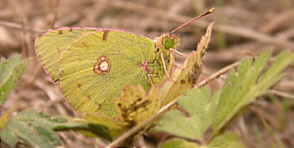 Picture - Robert Wilton |
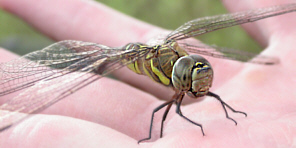 Picture - Andrew Easton
Picture - Andrew Easton |
The
first Migrant Hawker Aeshna mixta of the year was in
a north Lowestoft garden on the 2nd. By the end of the month hundreds
were along the coastal belt. This one was picked up from the side
of a road where it had presumably had a close call with a car. |
